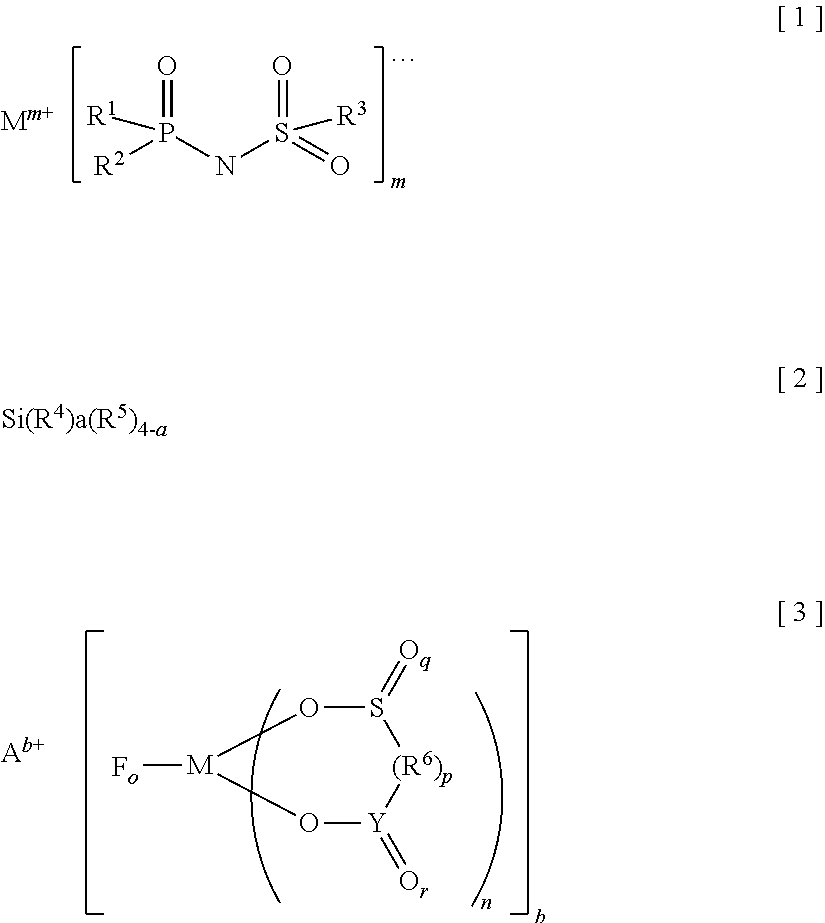Electrolyte for non-aqueous electrolyte cell, and non-aqueous electrolyte cell wherein same is used
a non-aqueous electrolyte and electrolyte technology, applied in the direction of non-aqueous electrolyte cells, cell components, electrochemical generators, etc., can solve the problems of significant increase in internal resistance to lower the low-temperature characteristic, and none of these batteries are sufficient for various applications in terms of respective characteristics, etc., to suppress internal resistance, suppress an increase in internal resistance, suppress the effect of gas generated
- Summary
- Abstract
- Description
- Claims
- Application Information
AI Technical Summary
Benefits of technology
Problems solved by technology
Method used
Image
Examples
example 1-1
[0194]The conditions for preparation of non-aqueous electrolytes are shown in Table 1, and the evaluation results of the resultant batteries containing the electrolyte are shown in Table 2. In Table 2, the values of the internal resistance characteristics of the batteries at −30° C. and the values of the amounts of gas generated are those relative values as compared with the internal resistance after a charge-discharge cycle test and the amount of gas generated associated with a charge-discharge cycle test, of a laminated cell assembled using an electrolyte No. A-35, respectively, designated as 100.
[0195]Using a mixed solvent of ethylene carbonate, dimethyl carbonate and ethyl methyl carbonate as a non-aqueous solvent in a volume ratio of 3:3:4 was used and in order to achieve a concentration of LiPF6 as a solute at 1.0 mol / L in the solvent, a lithium salt of the compound No. 1 as an imide anion-containing salt (the Cl content of the imide anion-containing salt, as a raw material, b...
examples 1-2 to 1-34
[0202]Non-aqueous electrolytes Nos. A-2 to A-34 were prepared and evaluated in the same manner as in Example 1-1 except that the conditions for preparation of non-aqueous electrolytes shown in Table 1 were adopted. The results of evaluation of the resultant batteries containing the electrolytes are shown in Table 2. The Cl content of each imide anion-containing salt used in the examples was not higher than 200 ppm by mass. The concentration of free acid in each electrolyte used in the examples was not higher than 100 ppm by mass. In Table 2, the values of the internal resistance characteristic of the batteries at −30° C. and the values of the amount of gas generated are relative values relative to the internal resistance after the cycle test and the amount of gas generated associated with the cycle test, of a laminated cell assembled using the electrolyte No. A-35, respectively, designated as 100.
Comparative Examples 1-1 to 1-3, Reference Examples 1-1 and 1-2
[0203]Non-aqueous electr...
examples 2-1 to 2-47
, Comparative Examples 2-1 to 2-30
Experimental Example 1 Wherein Additional Solute and Additive were Added
[0211]Non-aqueous electrolytes Nos. B-1 to B-77 were prepared and evaluated in the same manner as in Example 1-1 except that the conditions for preparation of non-aqueous electrolytes shown in Table 8 were adopted. As for the electrolyte, each electrolyte contains 1.0 mol / L of LiPF6 as a solute and the concentration of the total amount of the compounds represented by the general formulae [2] to [5] is lower than 5 ppm by mass. The concentration of free acid in each electrolyte used in examples was not higher than 120 ppm by mass.
[0212]The results of evaluation of the resultant batteries containing the electrolytes are shown in Table 9. In Table 9, the values of internal resistance characteristics of the batteries at −30° C. and the values of the amount of gas generated are relative values relative to the internal resistance after the cycle test and the amount of gas generated as...
PUM
 Login to View More
Login to View More Abstract
Description
Claims
Application Information
 Login to View More
Login to View More - R&D
- Intellectual Property
- Life Sciences
- Materials
- Tech Scout
- Unparalleled Data Quality
- Higher Quality Content
- 60% Fewer Hallucinations
Browse by: Latest US Patents, China's latest patents, Technical Efficacy Thesaurus, Application Domain, Technology Topic, Popular Technical Reports.
© 2025 PatSnap. All rights reserved.Legal|Privacy policy|Modern Slavery Act Transparency Statement|Sitemap|About US| Contact US: help@patsnap.com



